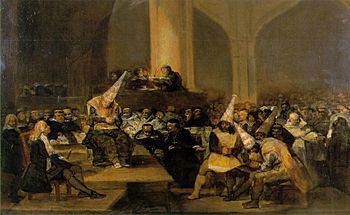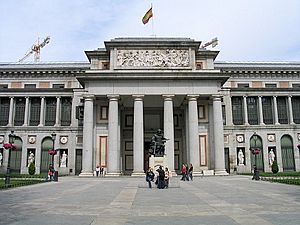Enlightenment in Spain facts for kids
The Enlightenment was a time in the 1700s when new ideas about science, government, and society became popular. These ideas, called the Ilustración in Spanish, arrived in Spain during the 18th century. This happened when the new Bourbon dynasty took over after the last House of Habsburg king, Charles II of Spain, died in 1700.
The Bourbon kings wanted to make Spain stronger and more modern. They focused on improving the government and building better roads and other important structures. King Charles III of Spain and his minister, José Moñino, 1st Count of Floridablanca, led many of these changes. These changes were part of what was called 'enlightened despotism'.
In politics and economics, the kings made many changes known as the Bourbon reforms. These reforms aimed to make Spain's overseas empire more successful, which would benefit Spain itself. The Enlightenment in Spain also encouraged more scientific knowledge. A monk named Benito Jerónimo Feijóo y Montenegro was a big supporter of this.
From 1777 to 1816, the Spanish government paid for scientific trips. These trips gathered information about the many plants and natural resources in the empire. When a scientist from Prussia, Alexander von Humboldt, wanted to explore Spanish America, Spain not only gave him permission but also told its officials to help him.
Spanish thinkers wanted to understand why their empire had become less powerful. They hoped to bring back Spain's former glory. In Spanish America, the Enlightenment also influenced smart, American-born Spanish men. The invasion of Spain by Napoleon Bonaparte's army caused big problems for Spain and its empire. Some historians believe the ideas of the Spanish Enlightenment helped cause the Spanish American wars of independence, but it was a very complicated situation.
Contents
Spain Under the Bourbon Kings
The French Bourbon family had a strong claim to the Spanish throne. This was because the last Habsburg king, Charles II, died in 1700 without any children to take his place. After a big fight called the War of the Spanish Succession, the Bourbon family became the rulers of Spain. They agreed that the Spanish and French crowns would never join together. They also gave up some Spanish lands in Europe.
Once they were firmly in charge, the Bourbon kings started many changes. They wanted to make the Spanish empire strong again, as it had become much weaker under the last Habsburg rulers. The ideas of the Age of Enlightenment had a big effect in Spain. These ideas also spread to Spain's empire overseas, leading to the Spanish American Enlightenment.
Even though the Enlightenment often questioned the power of the church, Spain and Spanish America kept Roman Catholicism as a very important part of their identity. When French forces led by Napoleon invaded Spain and put Napoleon's brother Joseph on the throne, it caused a huge crisis. People in Spain and its empire questioned who their true ruler was.
The Cortes of Cádiz was a group that acted as a temporary government. In 1812, they created a new constitution that limited the power of the king and the Catholic Church. King Ferdinand VII of Spain said he supported this new constitution. But when he got his power back in 1814, he canceled it and ruled as an absolute monarch again.
During the time Napoleon controlled Spain, many parts of Spanish America started wars to become independent. So, by the time Ferdinand VII returned to the throne in 1814, much of Spanish America had already gained freedom. They had also set up their own governments based on constitutions. New Spain (which is now Mexico) and Peru were the last to become independent, in 1821 and 1824. Mexico even had a brief period with a king before becoming a republic.
Enlightenment Ideas in Spain
Enlightenment ideas from France arrived in Spain after the Bourbon family took the throne in 1715. In Spain, just like in many other parts of Europe, the Enlightenment didn't completely change the way kings ruled. They still kept their power and the existing social order.
One very important Spanish thinker was Benito Jerónimo Feijóo y Montenegro (1676–1764). He was a Benedictine monk and a professor. He was great at sharing new ideas with many people. He encouraged scientific thinking and using facts to disprove old myths and superstitions. In his book Teatro crítico universal (1726–39), he sadly noted that "physics, and mathematics are almost foreigners in Spain."
The 1700s was a time when kings across Europe gained more absolute power. They wanted to weaken rivals like the Catholic Church. They also aimed to modernize their governments and boost their economies to become richer and more powerful internationally. In Spain, Enlightenment ideas arrived around 1750. They focused on reforms that would make Spain more prosperous and help it regain its place as a major world power.
People paid a lot of attention to medicine and physics, along with some philosophy. Visitors from France and Italy brought new ideas. However, unlike in France, there was little challenge to Catholicism or the Church in Spain.
A leading Spanish intellectual was Gaspar Melchor de Jovellanos, who was the Minister of Justice. He urged "patriots" to study Spain's legal history. He felt Spain had failed to keep its original government pure. In his report Informe en el expediente de ley agraria (1795), he criticized how much land was owned by nobles and the Church. This left most Spaniards without land. A solution he suggested was to sell all Church lands.
Some historians, like Jonathan Israel, argue that King Charles III didn't care much about the Enlightenment. They say his ministers were mainly focused on strengthening the monarchy and the empire. Only a few officials were truly committed to Enlightenment goals.
Science and Religion in the Enlightenment

The Enlightenment emphasized using scientific methods to understand the world. This sometimes clashed with traditional religious views. The Spanish Inquisition had the power to ban books and stop ideas it didn't like. However, Enlightenment ideas still spread in Spain.
By the 1770s, conservative groups tried to fight back. They used censorship and the Inquisition to stop Enlightenment ideas. But even then, important books like the French Encyclopédie were still available to people who wanted to read them. Writings by famous thinkers like Montesquieu, Rousseau, Adam Smith, and Carl Linnaeus were read by educated people in Spain.
The terrible 1755 Lisbon earthquake and tsunami destroyed much of Portugal's capital. It was felt all over Spain and beyond. People debated whether the earthquake was a punishment from God or a natural event.
Scientific Expeditions and New Institutions
The Spanish government paid for many scientific expeditions. They also allowed foreign scientists, like Charles Marie de La Condamine and Alexander von Humboldt, to visit their overseas empire, which was usually closed to outsiders. There were long Royal Botanical Expeditions to Chile and Peru (1777–88), New Granada (1783–1816), and New Spain (1787–1803).
These trips created many detailed drawings of plants and collected specimens. These were sent to the Royal Botanical Garden and the Royal Natural History Cabinet in Madrid. The Malaspina Expedition was another important scientific journey led by Spanish naval commander Alejandro Malaspina. For five years (1789–94), naturalists and artists gathered information for the Spanish king. The artists drew many plants, coastal views, and pictures of local people. In Mexico, the Malaspina Expedition helped start a botanical garden in Mexico City and a Museum of Natural History. The government also funded the Balmis Expedition in 1804. This trip aimed to vaccinate people in the colonies against smallpox.
Much of the scientific research done by the Spanish government in the 1700s was never published. This was partly because the government didn't have enough money. However, since the late 1900s, there has been a lot of new research on the history of science in Spain. Many old documents are now being published, and new studies are coming out. One exception was Alexander von Humboldt. He paid for his own scientific findings and observations to be published after his trip to Spanish America from 1799–1804.
New Institutions and Architecture
Even at the start of the Bourbon era, Spain began creating new places to support intellectual research. The Spanish National Library was founded in 1711, the Royal Spanish Academy in 1713, and the Royal Academy of History in 1738.
Later in the 1700s, more institutions were created to promote science. The Royal Botanical Gardens (1755) in Madrid received many plant specimens from the Malaspina Expedition. In Mexico, the government established the School of Mines (1792). This school, based on a similar one in Spain, aimed to increase scientific knowledge about mining silver, which was Spain's most valuable resource.
To help organize Spain's history and support King Charles III's centralizing policies, the General Archive of the Indies was created in Seville in 1785. This archive brought together all documents related to Spain's overseas empire.
The Palacio de Minería in Mexico City was designed in the neoclassical style by Spanish architect Manuel Tolsá. The Spanish king had ordered that "all new churches and other public buildings should be constructed in the neo-classic style." Their designs had to be approved by the Academy of San Fernando. Madrid also had many buildings built in the neoclassical style. Charles III's architect, Juan de Villanueva, designed a neoclassical building in 1785. It was meant to hold the Natural History Cabinet, but it later became the Prado Museum, famous for its paintings and sculptures.
See also
 In Spanish: Ilustración en España para niños
In Spanish: Ilustración en España para niños
- Age of Enlightenment
- History of Spain
- History of Spain (1700–1810)
- Social class in 18th-century Spain
- Spanish American Enlightenment
- Spanish Enlightenment literature



